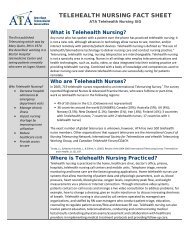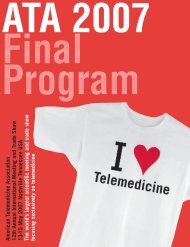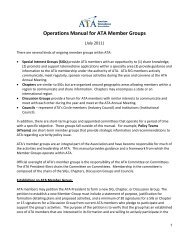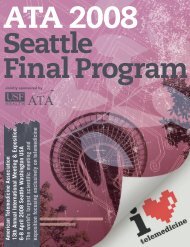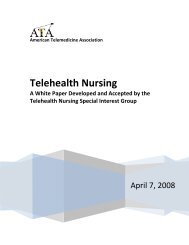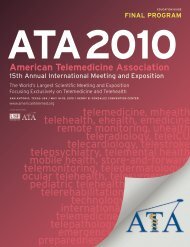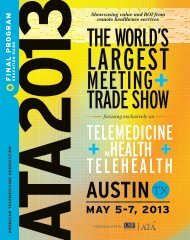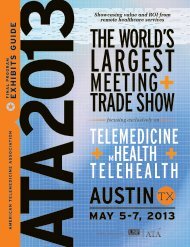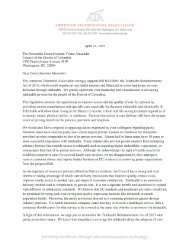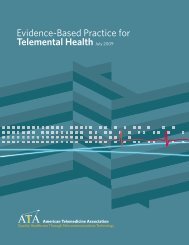Telemedicine
Presentation Abstracts - American Telemedicine Association
Presentation Abstracts - American Telemedicine Association
You also want an ePaper? Increase the reach of your titles
YUMPU automatically turns print PDFs into web optimized ePapers that Google loves.
CONCURRENT ORAL PRESENTATIONS ABSTRACTSpresented to outline an organizational strategy to increase retained earningsthrough a comprehensive reimbursement and revenue strategy from Tele-Health initiatives.Objectives:1. Understand the different payer models including Medicare, Medicaid,and private pay.2. Identify key steps in implementing a comprehensive payment strategy.3. Knowledge of implementation steps in a reimbursement strategy.Objectives:1. Participants will learn the critical success factors for telemedicineimplementation in organizations.2. Participants will learn the steps of change management applied totelemedicine.3. Participants will judge their organizational readiness for change.3:00 pm–4:00 pm Monday, May 6, 2013HOW-TO PANELSession Number: 021Session Title: 641 IMPLEMENTING TELEMEDICINE:ON TARGET, ON TIME, & ON BUDGETTrack: Finance and Operations II Ballroom FPRESENTERS AND CONTRIBUTING AUTHORS:Robert N. Cuyler, PhD, President 1 , Dutch Holland, PhD, President 21 Clinical Psychology Consultants LLP, Houston, TX, USA, 2 HollandManagement Consulting, Houston, TX, USA.The complexity of telemedicine implementation in organizations is frequentlyunder-estimated, with the result that new programs miss deadlinesand budgets and under-perform in utilization and revenue. The history oftelemedicine includes many examples of excellent concepts that turn out to beunsustainable for a variety of reasons unanticipated at project start. Thisworkshop will apply the principles of organizational change management totelemedicine and address the critical steps involved in taking projects fromidea to functioning clinical service. The methodology presented here has beenproven in decades of experience in a variety of industries, including healthcare.The principles of change management can be applied to small projectswithin a department all the way to major strategic changes in large organizations.Using the theatre as a universal metaphor, the presenters will addressthe critical success factors of organizational change, including the roles ofleadership, communication of vision, and alteration of work processes. Thepresenters will address the negative impact on project implementation whenthe organization’s leaders are not clearly and demonstrably ‘on board’. Whiletelemedicine is often seen as technology-driven, successful implementation isreally predicated on a disciplined approach to project management that placestelemedicine technology in it proper context as only one component (andoften a secondary component) of a functioning program. Examples of successfuland faulty approaches will illustrate the critical decisions that projectmanagers face when leading organizational change and the resulting consequencesto telemedicine projects. The critical role of training will be addressedwith a broad ranging review of preparation of protocols, familiarity with newtechnology, and rehearsal of new roles prior to initiating patient care. Asorganizational transitions inevitably include revised roles for employees,management of personnel (including the key role of performance managementsystems) is a critical factor in telemedicine implementation. The principlesof change management will be tailored to telemedicine projects thatinvolve the linkage of multiple locations which may be within a single multisiteorganization or between unrelated organizations collaborating via contract.The roles of physicians (and other clinical providers) increase thecomplexity of telemedicine projects. Factors that are specific to physicianparticipation in telemedicine will be examined and related to project success.The presenters will challenge participants to review their organizationalreadiness for change and identify provide interactive discussion of strategiesto maximize success.3:00 pm–4:00 pm Monday, May 6, 2013PRESENTATION PANELSession Number: 022Session Title: 412 INTEGRATION OF INNOVATIVETELEHEALTH AND MOBILE APPLICATIONS FORSUBSTANCE USE DISORDERSTrack: Best Practices and Service Delivery Models I Ballroom GMODERATOR: Elizabeth Brooks, PhD, Instructor.University of Colorado Denver; Veterans Rural Health Resource Center,Denver, CO, USA.PRESENTERS AND CONTRIBUTING AUTHORS:Janelle Jones Wesloh, MBA, LADC, Executive Director of RecoveryManagement 1 , Jan A. Lindsay, PhD, Health Services Researcher, AssistantProfessor 2, , Jin Ho Yoon, PhD, Assistant Professor 31 Hazelden, Center City, MN, USA, 2 MIRECC & Menninger Department ofPsychiatry and Behavioral Sciences, Baylor College of Medicine, Houston, TX,USA, 3 Menninger Department of Psychiatry and Behavioral Sciences, BaylorCollege of Medicine, Houston, TX, USA.23–25 million adults in the United States meet diagnostic criteria for substanceuse and dependence. Only 2.3 to 2.5 million (1/10th of those that meetdiagnostic criteria) receive ANY kind of treatment. This creates an incrediblegap between those in need of help and those that receive it. An additional 65 to70 million people in the United States go back and forth across the line of nonproblematicuse of substance into harmful use (where the using impacts theperson’s health, productivity or relationships). This group, in need of brief andconvenient screening and interventions (to reduce use and prevent problemsfrom becoming worse) also represents a significant service gap. The use ofvarious forms of telehealth in the treatment of substance use disorders isgrowing and represents a key role in helping to close these gaps. Join ourpanelists as they review advances being used and developed in the screening,treatment and ongoing continuing care for substance use disorders to extendaccess and the range of services available to those with these disorders. Ourpanelists represent both private and public sectors in the substance treatmentfield and have expertise in how integrating these innovative tools can impactand improve the treatment experience and outcomes. The panelists are allactively working with telehealth applications in the substance use disorderfield, in a variety of modalities, across a wide spectrum of the care continuum.Examples will include: a Screening and Brief Intervention web-based tool;mobile apps for use during treatment to augment other evidence-basedpractices such as MET/CBT; mobile apps for use after treatment to teach essentialskills connected to core recovery principles; a tailored, web-basedrecovery support tool that includes integration of recovery coaching and EHR;the use of virtual reality for smoking cessation; the use of social-networkingand online mutual support meetings to increase and expand fellowship opportunities.The panel will discuss the utilization of evidence-based practicesin the development and delivery of these substance use disorder telehealthtools. Promising data analysis on the usage, efficacy and outcomes of thetools, including published research, will be referenced and presented.ª MARY ANN LIEBERT, INC. 2013 TELEMEDICINE and e-HEALTH A-45



